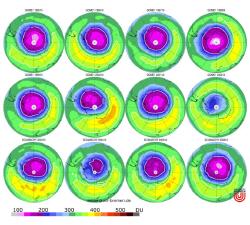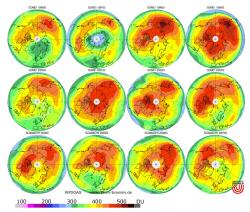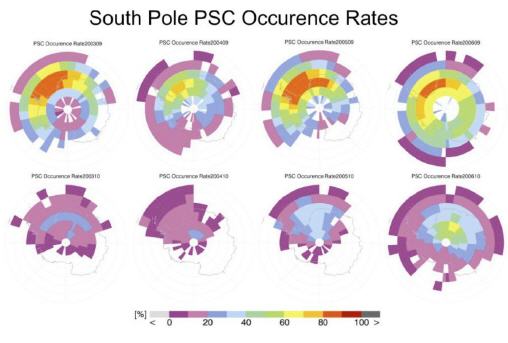The Antarctic ozone hole
Measurements of the atmospheric ozone content above the British Antarctic Research station at Halley Bay showed a massive decrease at the end of the southern winter since the late 1970s. The huge geographical extent of this ‘ozone hole’ (about the size of Russia) was discovered with the satellite instrument TOMS (Total Ozone Mapping Spectrometer). Figure 1 shows the ozone hole over Antarctica for the month of October from 1995 to 2006 as measured with the European satellite instruments GOME and SCIAMACHY.
Different scientific theories to explain the formation of the ozone hole competed with each other during the years following its discovery. Aircraft measurements made over Antarctica during southern spring 1987 identified chlorine as the main cause of the observed ozone destruction in the ozone hole. The physical and chemical processes leading to the massive ozone loss within the Antarctic ozone hole are now well established. Of great importance for the release of chlorine are the so-called polar stratospheric clouds (PSCs) that form in the polar winter stratosphere at altitudes between about 12 and 25 km (see Figure 2), where the temperature drops below about -78°C.On the surface of the PSC particles chemical reactions convert inert chlorine reservoir compounds into Cl2. At the end of the polar night solar radiation splits Cl2 into two Cl radicals, which then participate in catalytic ozone destruction. Ozone is almost entirely depleted at altitudes between about 15 and 20 km.
Significant ozone depletion was also observed in several Arctic winters in the northern hemisphere, but the degree of depletion varies strongly from year to year and depends on the meteorology of each individual winter. Stratospheric temperatures are generally higher during northern hemisphere winter than for southern winters, leading to lower and less extensive polar stratospheric cloud occurrence.

|

|
- Figure 1: (click for larger image)
- Left: October ozone distribution above Antarctica as measured by GOME and SCIAMACHY from 1995 to 2006.
- Right: Corresponding ozone distributions above the Arctic in March from 1996 to 2007. The thickness of the ozone layer is measured in Dobson units (DU). Above Antarctica the maximum ozone depletion is reached in the beginning of October every year, In contrast, larger variability in the ozone layer from year-to-year is observed in the Arctic. During cold Arctic winters (like in 1997) massive ozone loss has been observed that are similar to that observed in the southern hemisphere,. In warm Arctic winters (like in 1999) ozone levels are high.
- A strong stratospheric warming has been observed above Antarctica in 2002 leading to a weakening of the ozone hole. Because of the year-to-year variability in ozone, long time series of ozone observations are needed in order to verify ozone recovery beyond doubt. The ozone data shown here have been produced at the Institute of Environmental Physics of the University of Bremen

|
- Figure 2: (click for larger image)
- Frequency of polar stratospheric cloud (PSC) occurences observed by SCIAMACHY above Antarctica. Upper row: September 2003-2006, bottom row: October 2003-2006.
- For massive ozone destruction very cold temperatures, below -78°C, are needed to form polar stratospheric clouds. Reactions on the surface of such clouds are very rapid and convert inactive chlorine reservoir gases into active chlorine, that destroys ozone when the sun returns to the polar region. In September and October 2004 less PSCs were observed than in other years and resulted in less ozone depletion in October 2004 as seen in Figure 1.
(next page: Montreal Protocol)
|
Institute of Environmental Physics (IUP) Institut of Remote Sensing (IFE) University of Bremen, Otto-Hahn-Allee 1 28359 Bremen Deutschland contact to the IUP |

|

|